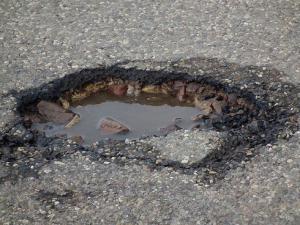Infrastructure protectionMicrowave repairs might annihilate zombie potholes once and for all
Some potholes are like zombies – they never die. Or at least that’s the perception of much of the driving public, especially as we enter peak pothole season: late winter and early spring. Recurring “zombie” potholes are too often a reflection of the type of method that’s used to patch or “fix” them – many of which are short-lived and only marginally effective. Researchers around the world are working to develop better and longer lasting repair alternatives. Microwave technology is not yet a routine method of repair, and it’s best-suited for potholes in asphalt rather than concrete. But this approach merits further consideration. After all, given our nation’s aging network of roads, zombie potholes will continue to flourish. Microwave repair could be an effective method for keeping them at bay.

Anyone who drives knows them, sometimes too well // Source: commons.wikimedia.org
Some potholes are like zombies – they never die. Or at least that’s the perception of much of the driving public, especially as we enter peak pothole season: late winter and early spring.
At a minimum, potholes create rough roads and poor driving conditions. Too often they degenerate into vehicle-damaging safety hazards that incur the wrath of drivers, attract negative attention from the news media and adversely affect commerce by disrupting or slowing traffic. Our nation’s deteriorating roads – of which potholes are an obvious manifestation – are a drag on our economy.
That’s why transportation department maintenance crews and pavement engineers continue to stress the need for more effective and efficient pavement repair and maintenance. From their perspective, the ideal repair would last at least a year, could be performed in all seasons, and could be installed easily and relatively quickly – all while keeping traffic delays to a minimum and repair costs down.
Recurring “zombie” potholes are too often a reflection of the type of method that’s used to patch or “fix” them – many of which are short-lived and only marginally effective. Researchers around the world, including my colleagues and me, are working to develop better and longer lasting repair alternatives. At the same time, researchers and pavement engineers in academia and in the private and public sectors are developing improved construction techniques and innovative pavement formulations – such as “self healing” materials – that will help prevent potholes from forming in the first place.
But we still have to deal with the millions of miles of roads – and their potholes – we already have.
Pothole repair is patchy
Potholes are symptomatic of underlying structural and/or pavement problems.
They form when water penetrates a crack. In cold climates, that water freezes and expands, pushing up on the overlying pavement. Repeated freezing and thawing is a great way to create a pothole. Water also softens and weakens the base material below a pavement, making it susceptible to deformation by passing traffic loads. As the base material deforms, the pavement loses structural support and breaks up. And another pothole is born!
Bottom line: a roadway marred by multiple potholes means the pavement is probably failing and should be replaced. But before that can happen, potholes still need to be repaired.
